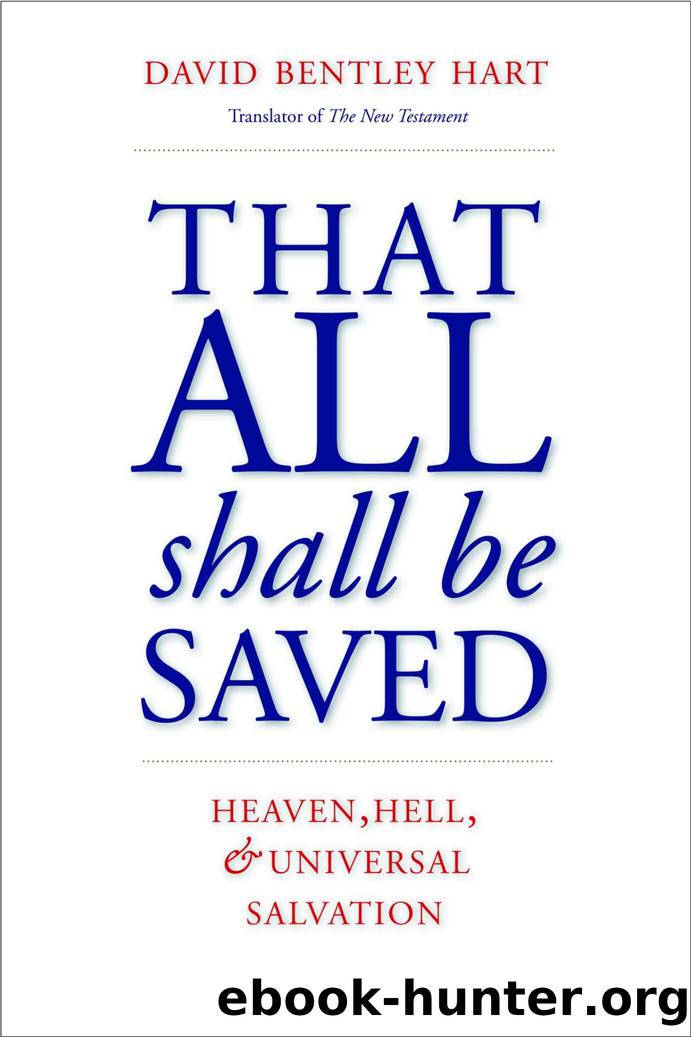That All Shall Be Saved by David Bentley Hart

Author:David Bentley Hart
Language: eng
Format: mobi, epub
ISBN: 9780300248739
Publisher: Yale University Press
Published: 2019-09-24T04:00:00+00:00
III
Then too, of course, so many serious exegetical debates coil and roil around the question of whether Christ’s teachings about judgment can be said to concern the difference between time and eternity at all, at least as a governing motif, rather than the difference between this age (in Hebrew, ‘olam ha-zeh) and the Age to come (‘olam ha-ba). Much depends, naturally, on how content one is to see the Greek adjective αἰώνιος, aiōnios, rendered simply and flatly as “eternal” or “everlasting.” It is, after all, a word whose ambiguity has been noted since the earliest centuries of the church. Certainly the noun αἰών, aiōn (or aeon), from which it is derived, did come during the classical and late antique periods to refer on occasion to a period of endless or at least indeterminate duration; but that was never its most literal acceptation. Throughout the whole of ancient and late antique Greek literature, an “aeon” was most properly an “age,” which is simply to say a “substantial period of time” or an “extended interval.” At first, it was typically used to indicate the lifespan of a single person, though sometimes it could be used of a considerably shorter period (even, as it happens, a single year). It came over time to mean something like a discrete epoch, or a time far in the past, or an age far off in the future. Plato in the Timaeus used it to indicate a kind of time proper to the highest heavenly realm, radically different from sublunary χρόνος, chronos, the terrestrial time of generation and decay. He also, incidentally, may have been the first to give the word the adjectival form aiōnios. One has to exercise some care even here, however, in making sense of any of these terms in Plato’s special usage. It is customary in translations of the Timaeus to render the noun chronos simply as “time,” the noun aiōn as “eternity,” and the adjective aiōnios as “eternal,” and credit Plato with the claim therefore that “time is the moving image of eternity”; but these are all, arguably, misleading translations.
For Plato, chronos and aiōn were not, respectively, time and eternity, but rather two different kinds of time: the former is characterized by change, and therefore consists in that successive state of duration (measured out by the sidereal rotations of the heavens) by which things that cannot exist in their entirety all at once are allowed to unfold their essences through diachronic extension and through a process of arising and perishing; the latter is characterized by changelessness and repletion, the totality of every essence realized in its fullness in one immutable state. Thus, the aeon above is the entire “Age” of the world, existing all at once in a time without movement (which is to say, change), wherein nothing arises or perishes, while chronos is the “moving image of the aeon,” the dim reflection of that heavenly plenum in a ghostly procession of shadowy fragments. Hence, Plato does not really use aiōnios to
Download
That All Shall Be Saved by David Bentley Hart.epub
This site does not store any files on its server. We only index and link to content provided by other sites. Please contact the content providers to delete copyright contents if any and email us, we'll remove relevant links or contents immediately.
Freedom of the Will by Jonathan Edwards(806)
Life Together by Bonhoeffer Dietrich(707)
The Lamb's Supper by Scott Hahn(657)
A Confession and Other Religious Writings by Leo Tolstoy(559)
In Praise of Folly by Desiderius Erasmus(531)
Selected Writings by Thomas Aquinas(528)
Small Victories by Anne Lamott(508)
The Divine Imprint by Russell Stannard(501)
The Lamb's Supper: The Mass as Heaven on Earth by Scott Hahn(493)
The Folly of God: A Theology of the Unconditional by John D. Caputo(475)
De Anima (On the Soul) by Aristotle(460)
An Essay In Aid Of A Grammar Of Assent by John Henry Newman(443)
The Pleasures of God: Meditations on God's Delight in Being God by Piper John(436)
Mark 9-16 by John MacArthur(435)
Victim of Grace by Robin Jones Gunn(433)
The Existence of God by Richard Swinburne(426)
A History of Anglican Exorcism by Young Francis;(425)
That All Shall Be Saved by David Bentley Hart(402)
Selected Writings (Penguin Classics) by Aquinas Thomas(384)
